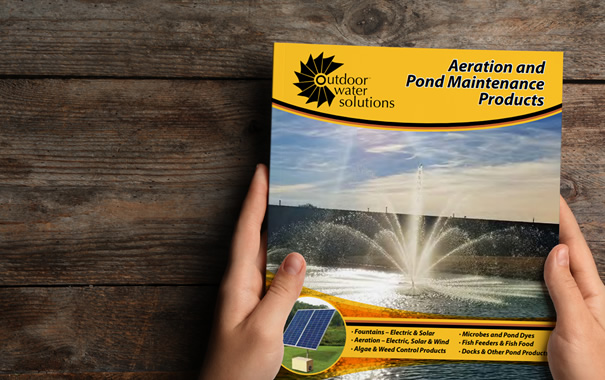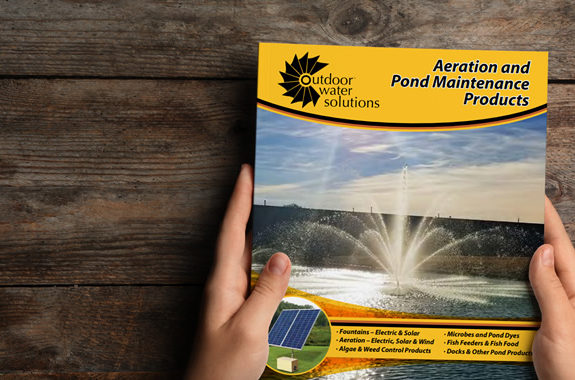Here are the answers to some of the questions that come up often. If you have other questions, feel free to contact us.
Frequently Asked Questions
Windmills
Usually, this happens when you have low wind speeds or winds coming from multiple directions vs. a head on wind. The rocking back and forth is due to the backpressure on the system. If you have your diffuser at 12’, then it will take about 5 pounds of pressure to push air thru the airlines.
To build up 5 lbs. of pressure it might take a 4, 5 or 6 mph wind to get the head to turn. This is a normal part of operation, especially at low wind speeds or if you have inconsistent winds. If you have tree’s or buildings within 200-300’ of your windmill, they might block the wind or cause the wind to “swirl”, which can sometimes prevent your windmill head from finding a straight on wind.
At low wind speeds, the windmill might only be producing .5 to 1.0 CFM of air. This is sufficient for one diffuser, but probably isn’t enough air to operate two diffusers. As your wind speed picks up, the second and even third (if you have one) diffusers should kick in if your valves are adjusted appropriately.
Air will always go to the point of least resistance. If one diffuser is a little shallower or has a shorter airline, it will want to take most of the air. You’ll have to restrict the airflow to this diffuser with a valve system so that air is forced out of your other air stones.
Yes, you can use a hydraulic needle valve to adjust the airflow if you want. These can be purchased online at Northerntool.com or Grainger.com or in your local farm store. Most have a ¼”, 3/8” or ½” female NPT threads on both sides. You can purchase a brass fitting with male threads on one side and a hose barb on the other side and connect it in-line if you want a more precise adjustment.
We sell several different styles of diffusers. Some have their own bases and some do not. The air stone diffuser does not have a base so we put it inside of a bucket to keep it out of the mud and the muck on the bottom and to also weight it down into something so it sits on the bottom flatly and pushes air and water upwards. We recommend adding some rock, sand or concrete to the bottom of the bucket for weight and tying a marker onto the bucket so that you can raise and lower it or move it if needed.
Your air stone diffuser will give you the best performance if you clean it every year or two. If you raise it up and it looks clean, then just lower it back down. If it has mud, algae or other things clogging the pours, then it should be cleaned. You can use a 10% solution of muriatic acid or give it a gentle cleaning with a steel brush.
Putting it into a clean bucket of water and blowing air through it after cleaning is a good way to make sure the pores are open and that it’s operating correctly. If you have a rubber membrane diffuser, it may not need to be cleaned. You can check it by blowing air through it to check it’s performance.
Very little. We use high-quality sealed bearings so there is nothing to grease inside of the compressor. You might have to change out the diaphragm and check valves every 4-7 years. Other than that, you should periodically check your air stone diffuser and clean it, if necessary, every year or two.
This can vary greatly. If this is your first windmill, then plan on taking one day with two people to build the tower and head assembly and a second ½ day to physically set the windmill, anchor it and run your airlines and diffusers. Most people do this over a 2 day weekend or over several evenings. The key is to make sure you have plenty of time and don’t get in a big hurry!
Our pond experts strongly recommend using a secondary anchor system. We supply 4’ ground stakes but encourage people to set these into concrete (either as a footing or as a pad).
The second alternative is to use a screw in an earth anchor and to set this in the middle of the windmill tower. You can then use plastic coated cable and tie into the three sides of the windmill to secure it.
You can set your windmill up to 1000’ feet away from the pond and still aerate it. We see minimal friction loss with air, especially with our larger ½” airline.
Yes, we do carry a full line of replacement parts for most aeration windmills. We manufacture these replacement components to our high quality performance specs.
We have replacement blades, blade braces, hub assemblies, domes, tail arms, tail fins, tower pieces, stake clamps, diaphragms and check valves. All of our parts are offered at a lower price than the original equipment manufacturer. We have a parts warehouse in the U.S., Western Canada and in Eastern Canada.
Tower hinges are our #1 windmill aerator accessory and make it much easier to install a windmill or to service it.
Weighted airline is #2 in that it lets your airline sink to the bottom of the pond vs. having it floating on the surface. This keeps it from getting caught by boats, swimmers, fishing hooks, etc.
Either a freeze control system or pressure relief valve is also very popular in that both protect the compressor in climates where you have may freezing. Lastly, we sell a lot of air stone housing buckets and air stone markers.
In Northern climates, we recommend either a freeze control tank or a pressure relief valve in most situations. The freeze control tank insures your airlines stay open in that they release a small amount of isopropyl alcohol into the airline to unthaw it if it freezes due to condensation. The pressure relief valve is an alternative to the freeze control tank and releases back pressure at about 20 psi. This protects the compressor should your airlines ever freeze but doesn’t unthaw them. If you’re running multiple diffusers, you may not need a freeze control tank, especially if you split the airlines coming down the windmill tower as you have a lower probability of multiple airlines freezing at once. Please call 1-866-471-1614 and we’ll evaluate your pond’s situation.
Theoretically, we can pump water using an airlift pump. We do not currently sell any water pumps but airlift pumps are available online. The key is depth and submergence as both are critical when using an airlift pump.
Local Services
We have expert pond technicians that will be able to come by to identify and recommend products to help get unwanted growth under control. We can then apply the products ourselves, or guide you step by step on the application process.
Technician visits are typically scheduled within a few business days, depending on your location and service needs. Our team works hard to provide timely, efficient service and will confirm your appointment as soon as possible.
Aeration has several benefits to ponds and lakes. For one, it breaks up the thermal stratification in the water. This allows dissolved oxygen to make its way through the whole body of water, rather than just surface level water. This has a beneficial effect for the fish because they will be able to forage deeper than before do to an abundance of oxygen.
Additionally, when dissolved oxygen is present at the bottom of the pond, it allows certain aerobic bacteria to decompose organic matter buildup. At the end of the day, pond aeration helps improve your pond’s water quality over time by reducing excess nutrients, which makes it harder for unwanted weeds and algae to grow.
Aeration will not kill the algae already present in a pond. It will, however, lower the nutrient load in the pond, making it harder for future algae growth.
It depends. Since no two ponds are the same, there is a lot to consider when developing a treatment plan for a specific body of water. We offer comprehensive water quality testing to gain insight into what is going on at the chemical level in the water. This is the best way to ensure that the treatment plan is targeting the correct problems and imbalances in the water.
Another thing we consider is what the client’s end goal for the body of water is. For example, if the client is wanting to raise a trophy bass lake, where vegetation is needed, applying chemical would be a last resort. On the other hand, if the end goal is a swimming hole, excess vegetation would be a nuisance and would likely require chemical application.
Yes! We are trained professionals and have extensive experience in repair of all manufacturers of floating lake fountains.
Unfortunately, we do not do any kind of mechanical removal of vegetation or physical cleaning of koi ponds.
Yes, we offer effective pond sealant products designed to seal pond leaks—and we can help with application, too. Let’s get your pond back in shape!
We have licensing & are insured in Arkansas to commercially apply aquatic pesticides.
Combined our service department has over 22 years of experience in this industry.
We are staffed an Aquatic Biologist with a Bachelor’s in Science in Biology from the University of Arkansas.
Our services are below market average and affordable for the average pond owner. For more information or to receive a quote for our services, please feel free to call 1-866-471-1614
We will travel anywhere within, roughly, a 60 mile radius from Springdale, AR. If you have any questions or would like to talk to one of our pond experts, please call 1-866-471-1614 today!
Yes, we offer full installation for all our products locally. We build and test each system here in house before each installation.
Yes, we have 16 foot Skiff boat and a kayak for shallow waters.
We offer consultations for local ponds as well as comprehensive water quality testing. We offer one time visits, maintenance programs for floating lake fountains and lake aerations, as well as a contractual program. With a lake management contract, one of our pond technicians would come out twice a month in the Spring and Summer months and once a month the rest of the year. While there, we would assess the needs and wants of the client and proceed accordingly. If there is trash bordering the pond, we will pick it up.








